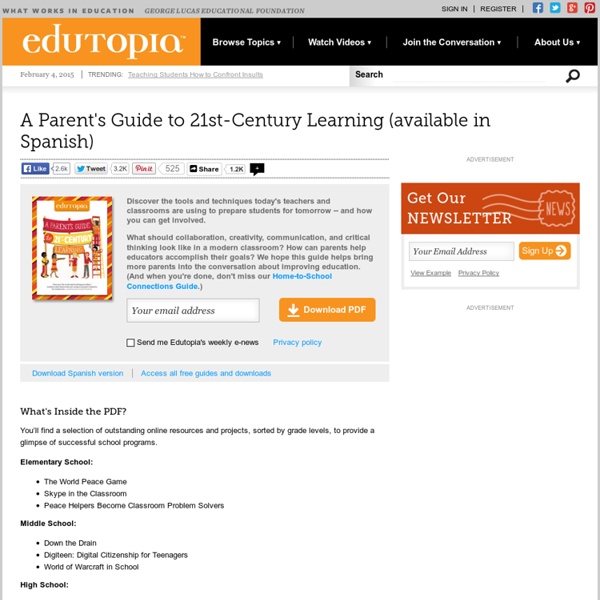A Parent's Guide to 21st-Century Learning
You’ll find a selection of outstanding online resources and projects, sorted by grade levels, to provide a glimpse of successful school programs. Elementary School: The World Peace Game Skype in the Classroom Peace Helpers Become Classroom Problem Solvers Middle School: Down the Drain Digiteen: Digital Citizenship for Teenagers World of Warcraft in School High School: World Youth News Digital Youth Network Money Corps: Finance Experts as Guest Teachers Across the Grades: More Ideas that Work Ten Tips to Bring 21st-Century Skills Home Resources: Bring the C's to Your School
Every Student Response Strategies | LessonCast
True implementation of personalized learning in schools requires a shift in the roles of educators and a shift in educator professional learning. This course examines the evolving role of teachers incorporating personalized learning experiences in the classroom. Taking a close look at what personalized learning is and isn’t, participants create resources to support teacher roles as facilitator, assessor, instructional designer, content curator, coach, and advisor, and family-school collaborator. Lessoncast believes in personalized professional learning. While the course opens on July 21 (8:00 am EST), you may register at any time and complete the course activities at your own pace.
Abdication of Education: How can we Re-engage Parents?
It isn’t a decision that any of us made consciously or willingly, it’s more the result of circumstances, but as a society we have abdicated the education of our children to a specialized segment of society. That segment has taken the responsibility we’ve given it and created an intricately structured system of learning as well as a system of administration of that learning. So now, here we are, dissatisfied with the cost and effectiveness of those systems and wondering what we can do about it. It didn’t happen because we didn’t want to be involved, it’s more the result of the pace of our lives and the structure of the educational system which makes it very difficult to be involved. By the time our kids are teenagers, the closest some of us come to being involved in education is dropping them off at school or a bus stop. Every parent starts out being the most important teacher in their child’s life. Thankfully, other people have realized that same thing are are doing something about it.
Tips for Writing Instructional Objectives - Bloom's Taxonomy Job Aids
I am so delighted to see this post that includes Bloom's Taxonomy Wheels by ZaidLearn. I always find that it's far easier to design materials using these wheels than it is to see the verbs/products in lists. Many instructional designers can benefit from these job aids when trying to find the right action verbs for their objectives. Here are some wheels for the cognitive domain. Source: Source: Source: Bloom’s digital taxonomy. Have fun, designers!
untitled
Creative, child-centered art and literacy ideas and activities
untitled
Literature Circle Models
After experimenting for many years, I discovered an approach that's easy, fun, and effective. I refer to it as Classroom Book Clubs because it's a more relaxed method of doing Literature Circles that doesn't involve roles. You can view a narrated slidecast to this model by scrolling down to the Classroom Book Clubs section. On this page you can also learn about different types of Literature Circles. Ways to Structure Literature Circles Classroom Book Clubs - My favorite method at the moment is a flexible approach to Literature Circles that does not require the use of extensive handouts and assignment booklets. Classroom Book Clubs I love this model because it's a very flexible and fun approach. Mini Literature Circles (Using Leveled Readers) Are you required to use a basal reading program in your classroom? Assign 3 or 4 students to a leveled reader based on their reading level. Literature Circles with Roles Some students enjoy having roles within their Literature Circles.
comic life
Comic Life 3 is now available for both Mac and Windows! “4 Stars and Editors Choice.” MacUser Dec. 2013 "Awesome!... It's intuitive and it has a wider selection of title treatments and templates - love the retro look!" Chris Shoemaker, Co-Founder of Freshi Media "Outstanding." Ever wanted to be a character in a comic book? It's the app with everything you need to make a stunning photo comic.Fonts, templates, panels, balloons, captions and lettering art. Comic Life is also great for doing school projects, how to guides, flyers for your business or group, storyboarding, lesson plans, book reports, Internet memes; and that's just to name a few! Creating an original work is easy with the script editor. Photo filter effects and all our lettering options really make your photos come alive. When you're done you can share your masterpiece with your fans in a variety ways. Make it your story. Script Editor Get your words straight before starting your layout.
Related:
Related:



